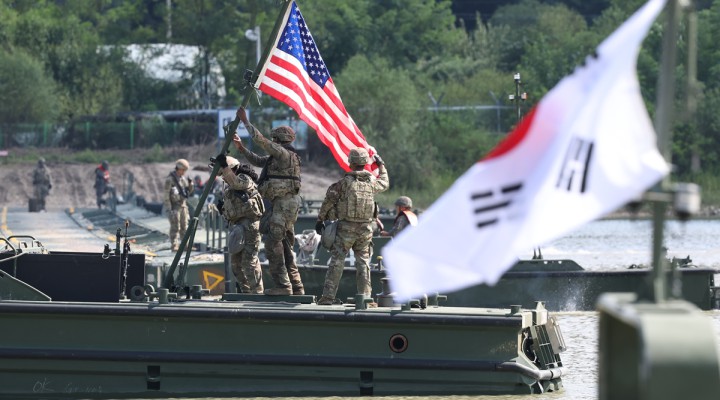US-led drills create problem, not solution

US-based Stars and Stripes reported that in mid-September drills featuring the USS America amphibious assault ship along with warships from South Korea and Canada were “in response to continuing tension with North Korea.” The same report noted that the US and South Korea have carried out a number of exercises this summer alone around the Korean Peninsula.
However, nowhere in the article was there any mention of the source of this “continuing tension.”
Following the drills, a reenactment of the September 15, 1950 “Operation Chromite” amphibious assault was conducted, linking the recent US-led military drills to the US-led Korean War of the 1950s. The persistent presence of foreign military forces on North Korea’s borders, including frequent military exercises off its coasts, has driven tensions on the Korean Peninsula ever since the armistice was signed in 1953.
The US military presence in South Korea as well as Washington’s interference in South Korea’s internal political affairs and what is essentially the political capture by Washington of Seoul, has artificially maintained distrust, distance and military tensions between North Korea and South Korea.
Over the decades, when Washington has found itself distracted from East Asia, tensions between North Korea and South Korea almost always ease and in some cases, quite significantly, demonstrating just how central the US military occupation and political capture of South Korea are to driving tensions on the peninsula. In fact, maintaining artificial tensions on the Korean Peninsula is a pretext for an enduring US military presence on China’s doorstep across the Yellow Sea.
Together with US military bases stretching across Japanese territory and now as far south as the Philippines, the US presence in South Korea is clearly just one part of a larger policy of encirclement and containment of China. While the US cites “continuing tensions with North Korea” as a pretext for its military presence in South Korea, it is clear the primary purpose for it is to encroach upon China.
This is a long-standing US foreign policy objective stretching all the way back to the end of World War II. In fact, in a 1965 memorandum from then US secretary of defense Robert McNamara to then US president Lyndon B. Johnson titled, “Courses of Action in Vietnam,” it was admitted that US’ continued pursuit of war in Southeast Asia only “made sense” if it was “in support of a long-run United States policy to contain Communist China.”
The same memorandum also noted the three primary fronts the US would concentrate on in order to contain China including the “Japan-Korea front,” along with India-Pakistan as well as Southeast Asia. From when this memorandum was written in 1965 to the present day, it is clear that the US government, regardless of who occupied either the White House or Congress, has pursued the containment of China across these three fronts and beyond.
The containment of China does not benefit the nations along these three fronts, including South Korea. Seoul has been forced repeatedly to sign onto Washington’s many anti-China projects including more recently the CHIPS Act which threatens South Korea’s extensive cooperation with China regarding semiconductors. South Korea now finds itself on the losing end of Washington’s broadening confrontation with China. Seoul, understanding it had no choice but to sign the Act, has since asked Washington for exceptions from provisions within it that would surely cripple South Korea’s own semiconductor industry. The Act is clearly designed not only to hurt and hinder China’s technological development, but also that of Washington’s supposed “partners” including South Korea.
Beyond semiconductors, China is actually South Korea’s largest trade partner in terms of both imports and exports. Thus, each provocation Washington recruits Seoul into joining, such as hosting US nuclear-powered and armed submarines in its ports, is a provocation jeopardizing South Korean trade and its overall economic well-being.
While the recent US-led drills in the Yellow Sea were conducted “in response to continuing tensions with North Korea,” when one considers it is the US military presence in the region primarily driving those tensions, we see that the drills are creating the problem, not creating a solution. While the Western media attempts to portray South Korea as an ally or partner, considering the true nature of Washington’s relationship with Seoul, it seems more appropriate to describe South Korea as a hostage.
It is an added irony that China’s large economic partnership with South Korea helps temper the worst impulses of a US-influenced Seoul. The stronger China becomes, the less likely the US will be able to continue holding the threat of chaos over the region’s head to continue justifying its military presence, and all that it entails, across the region.
 TheAltWorld
TheAltWorld 
0 thoughts on “US-led drills create problem, not solution”